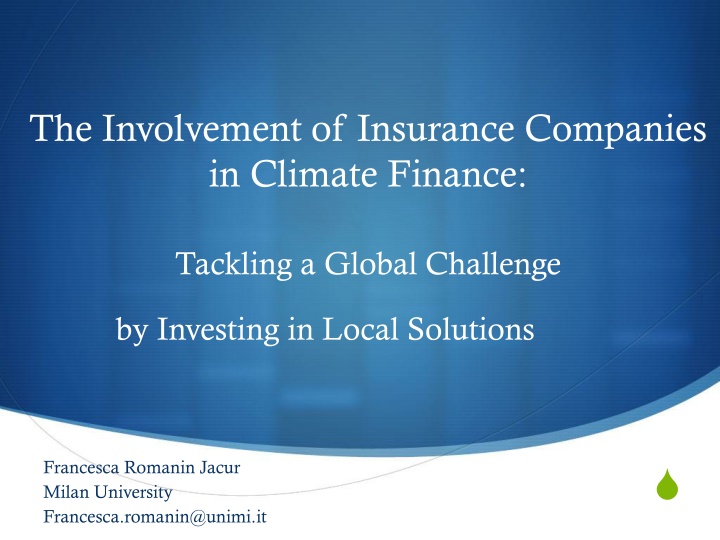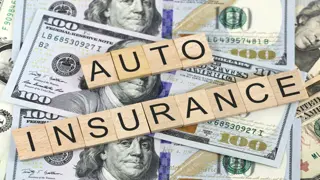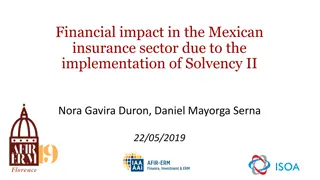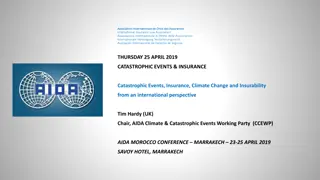The Role of Insurance Companies in Climate Finance: Addressing Global Challenges through Local Investments
Exploring the engagement of insurance companies in climate finance, this presentation highlights the significance of private sector involvement in tackling climate change at a local level. It delves into key concepts such as mitigation, adaptation, and the global scientific targets for combating climate change. The evolving climate change regime, financial pledges, and the architecture of climate finance are also discussed, emphasizing the need to catalyze new investments for climate mitigation and adaptation.
Download Presentation

Please find below an Image/Link to download the presentation.
The content on the website is provided AS IS for your information and personal use only. It may not be sold, licensed, or shared on other websites without obtaining consent from the author.If you encounter any issues during the download, it is possible that the publisher has removed the file from their server.
You are allowed to download the files provided on this website for personal or commercial use, subject to the condition that they are used lawfully. All files are the property of their respective owners.
The content on the website is provided AS IS for your information and personal use only. It may not be sold, licensed, or shared on other websites without obtaining consent from the author.
E N D
Presentation Transcript
The Involvement of Insurance Companies in Climate Finance: Tackling a Global Challenge by Investing in Local Solutions Francesca Romanin Jacur Milan University Francesca.romanin@unimi.it
Plan of the presentation A Dynamic International Regulatory Framework Climate finance The Increasing Involvement of the Private Sector Challenges and Opportunities for (Re-) Insurance Companies
Climate Change basic glossary Mitigation: reducing GHG emissions Adaptation: managing the effects of climate change, reducing vulnerability of human and natural systems The target: the global scientific community (IPCC) calls for limiting global warming to 2oC above 1990 levels Current pledges to reduce emissions meet of the emissions needed Towards a low carbon economy
Climate Change Regime: the UN Framework Convention and the Kyoto Protocol UNFCCC (1992) : Stabilization of greenhouse gases (GHG) concentration KP (1997) : by 2012: global GHG reduction target of -5%. Shortcomings deriving from limited active participation (no USA, no commitments by emerging economies China, India, BRIC) Post 2012: ongoing negotiations! COP meetings and the crisis of multilateralism, but what s the alternative? Climate change regime financial pledges: (nonbinding political agreement) 100 billion every year by 2020 (long term finance) 30 billion of fast start finance in 2010-2012
Climate Change Regime Architecture SB for Implementation UNFCCC COP KP SB for Technical Advice IPCC COP/MOP Compliance Committee World Bank Secretariat IE T JI CDM GEF Adapt. Fund LDC Fund 2% of levy on proceeds SCC Fund Grenn Climate Fund
Climate finance Working Definition: The channeling of public resources (towards developing countries) (for mitigation & adaptation) through frameworks and mechanisms that leverage private sector capital, and are in line with national development goals. Many sources: 50 international public funds, 6000 private equity funds, carbon markets, taxes, Clean Development Mechanism) Challenges: Catalyze new investment into climate mitigation and adaptation sectors Develop new products with replication potential across markets and geographies
Combining Developing Countries and the Private Sector Needs Gaining the trust of Developing Countries and of the Private Sector Need of coordination among financial institutions (national, bilateral, international) Trust in institutions and their procedures (Consistency of funding resources, transparency and inclusiveness, legitimacy) The impact of the financial crisis The need to conciliate different interests: Effective mitigation and adaptation action and environmental integrity Economic development and poverty reduction in Developing Countries Economic gain for the Private Sector
Financing Adaptation GOALS: Generate new finance Design and distribute goods and services that reduce vulnerability of individuals and communities to climate change Provide risk management tools TOOLS: Drawing on capital markets to raise new finance for adaptation (climate bonds) Direct credit lines to local finance institutions Innovative means: microfinance
The role of insurance companies Risk Reduction and Insurance Catastrophe prevention, Risk assessment, emergency responses Low rate of insurance penetration in developing countries Technical assistance for setting up innovative financial products, programmes or services for the low carbon energy sectors
Climate Risk Management by the Insurance Sector Public-private partnerships With International Financial Institutions (World Bank) At the country level Index-based insurance solutions Case studies Challenges and opportunities of implementing climate insurance
Thank you! Dr. Francesca Romanin Jacur francesca.romanin@unimi.it























